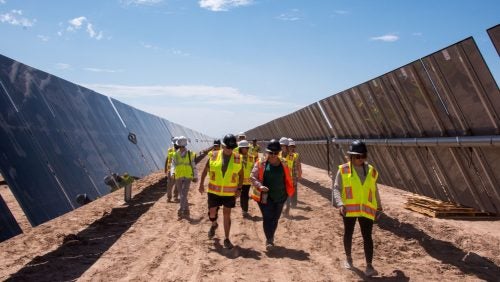The Irony of the One Big Beautiful Bill: How a Supposedly Anti-Renewable Bill May Supercharge Clean Energy
September 30, 2025 by Mia Reines

Bureau of Land Management staff walk around a solar construction site in Arizona in 2023.
Trump’s One Big Beautiful Bill Act aims to stifle renewables but may backfire spectacularly, forcing developers into a gold rush that accelerates clean energy deployment.
The One Big Beautiful Bill Act (“OBBBA”), supported by the Trump administration, is widely understood to be a regulatory attempt to slow the growth of renewable energy in the United States—particularly wind and solar—after the Inflation Reduction Act (IRA) accelerated the energy transition in 2022.[1] By leveraging national security and foreign influence concerns, the bill effectively weaponizes trade and procurement rules against clean energy infrastructure.[2] But in an ironic twist, the OBBBA may end up catalyzing a short-term boom in renewable energy development, while simultaneously revealing just how central renewable energy has become to the U.S. grid and economy.
The OBBBA primarily attempts to weaken the renewable energy industry through restrictions on tax incentives for projects that receive “material assistance” from a Foreign Entity of Concern (FEOC).[3] FEOC provisions apply to prohibited foreign entities (PFEs)—most notably, China.[4] Generally speaking, there are two types of PFEs: specified foreign entities (SFEs) and foreign-influenced entities (FIEs).[5] FEOC provisions restrict tax incentives for taxpayers who are PFEs or receive material assistance from PFEs.[6] However, there is a transition period: projects with Chinese ties can still qualify for tax credits if they start construction before 2026 and are completed by 2028. All other projects must begin construction by July 4, 2026, or be placed in service by 2028 if starting construction after that date.[7] For clean energy developers, this presents an extremely challenging timeline. Despite growing domestic investment, the solar and wind sectors still rely heavily on Chinese-manufactured photovoltaic (PV) panels, batteries, rare earth components, and wind turbine parts.[8] Therefore, with FEOC regulations taking effect rapidly, many projects will lose eligibility for the Inflation Reduction Act’s tax credits if they do not begin construction before the OBBBA’s deadlines kick in.[9]
The result is a panicked gold rush among developers to lock in tax credits and shovel-ready status before the cutoff dates. Far from chilling clean energy investment, the bill is temporarily accelerating it.[10] Renewable energy developers are fast-tracking permitting, procurement, and groundbreaking on wind and solar farms nationwide to qualify for tax credits essential for project financing. This urgency will likely lead to one of the most significant short-term expansions of clean energy infrastructure in U.S. history.[11] Utility-scale solar in particular is poised for massive growth.[12] Unlike fossil fuel plants, solar and wind facilities can be deployed quickly, making them ideal for developers racing to meet construction deadlines.[13] Paradoxically, the OBBBA could generate precisely the kind of successful green energy buildout it sought to prevent, at least in the short term.
This accelerated buildout comes at a critical juncture for the U.S. power grid. Electricity demand is rising sharply, driven in part by the explosive growth of artificial intelligence and the massive data centers required to support it.[14] At the same time, the electrification of vehicles, heating, and industrial processes continues to push baseload demand upward.[15]
Natural gas plants, which have traditionally been viewed as a reliable means of adding capacity, are no longer a quick fix. Industry estimates suggest a wait of up to seven years for new gas turbine projects, due to permitting delays, financing uncertainty, and supply chain constraints.[16] By contrast, utility-scale wind and solar remain the fastest and cheapest generation assets to deploy, as they can be built within twelve to eighteen months.[17]
The OBBBA may therefore serve as an unintentional stress test for how dependent the U.S. has already become on renewable energy to maintain grid stability and affordability. The sheer volume of projects being rushed to completion will underscore a basic reality: it is now functionally impossible to meet America’s growing energy needs without renewables.
While the OBBBA may create a short-term clean energy boom, its long-term consequences could be politically volatile. As tax credits begin to dry up for future projects, developers will face funding gaps and higher costs. With fewer renewable projects in the pipeline, electricity prices could rise, particularly in states dependent on clean energy for marginal generation.[18] In that scenario, the public may not respond to the complex mechanics of trade policy or energy security. Instead, they will see rising energy bills—and may place blame squarely on the administration that enacted the policy.[19] The result could be significant political backlash, especially in swing states where energy affordability is a top voter concern.
The OBBBA’s attempt to throttle renewable energy may, for a brief moment, flood the U.S. grid with clean energy infrastructure. But this artificial acceleration, followed by a sharp drop in funding, could expose the fragility of politically motivated energy policy. More importantly, it reveals how embedded wind and solar have become in the U.S. energy economy and how challenging it will be to roll back the clean energy transition, even with federal resistance.
In the end, the OBBBA may be remembered not as the death knell of renewables, but as a desperate—and ironically catalytic—attempt to halt progress before the energy transition becomes irreversible.
[1] Erlyne J. Nazaire, The One Big Beautiful Bill Act: Changing the landscape for US clean energy, Thomson Reuters (Aug. 11, 2025), https://www.thomsonreuters.com/en-us/posts/sustainability/one-big-beautiful-bill-act-clean-energy/; One Big Beautiful Bill: Changes to Clean Energy Tax Credits and Implications for Clean Energy Project Developers and Investors, Thomson Reuters (July 10, 2025) [hereinafter Practical Law Finance]; Isabel Hoyos et al., America’s Clean Energy Transition Will Continue Despite the One Big Beautiful Bill Act, Col. Bus. Sch. (July 16, 2025), https://business.columbia.edu/insights/climate/one-big-beautiful-bill-setback-clean-energy.
[2] Hoyos et al., supra note 1; One Big Beautiful Bill Act, Pub. L. No. 119-21, 139 Stat. 72, 262 (2025).
[3] Nazaire, supra note 1.
[4] Id.
[5] Id.
[6] One Big Beautiful Bill Act, supra note 2, at 253.
[7] Id.; Heather Cooper et al., The One Big Beautiful Bill Act: Navigating clean energy tax credits in a new era, McDermott Will & Schulte (July 7, 2025), https://www.mwe.com/insights/the-one-big-beautiful-bill-act-navigating-clean-energy-tax-credits-in-a-new-era/.
[8] A. Chadly et al., State of global solar energy market: Overview, China’s role, Challenges, and Opportunities, 11 Sustainable Horizons (Sep. 2024), https://doi.org/10.1016/j.horiz.2024.100108.
[9] Practical Law Finance, supra note 1.
[10] Keith Martin et al., Effects of “One Big Beautiful Bill” On Projects, Norton Rose Fulbright (July 7, 2025), https://www.projectfinance.law/publications/2025/july/effects-of-one-big-beautiful-bill-on-projects/.
[11] Hoyos et al., supra note 1.
[12] Wood Mackenzie, Solar Market Insight Report Q3 2025, Solar Energy Industries Association (Sep. 8, 2025), https://seia.org/research-resources/solar-market-insight-report-q3-2025/.
[13] Brad Plumer, Want Cheap Power, Fast? Solar and Wind Firms Have a Suggestion., The New York Times (Mar. 17, 2025), https://www.nytimes.com/2025/03/17/climate/renewable-energy-trump-electricity.html?smid=url-share.
[14] Practical Law Finance, supra note 1.
[15] New Report Finds Urgent Need to Expand Energy Supply to Meet Rapidly Growing Future Demand, Am. Clean Power Ass’n (Mar. 10, 2025), https://cleanpower.org/news/us-national-power-demand-study/.
[16] Jared Anderson, US gas-fired turbine wait times as much as seven years; costs up sharply, S&P Global (May 20, 2025), https://www.spglobal.com/commodity-insights/en/news-research/latest-news/electric-power/052025-us-gas-fired-turbine-wait-times-as-much-as-seven-years-costs-up-sharply.
[17] Plumer, supra note 13.
[18] Sam Newell et al., A Wide Array of Resources is Needed to Meet Growing U.S. Energy Demand, Brattle, 9 (Feb. 2025), https://www.brattle.com/wp-content/uploads/2025/02/A-Wide-Array-of-Resources-is-Needed-to-Meet-Growing-US-Energy-Demand.pdf.
[19] Id.

